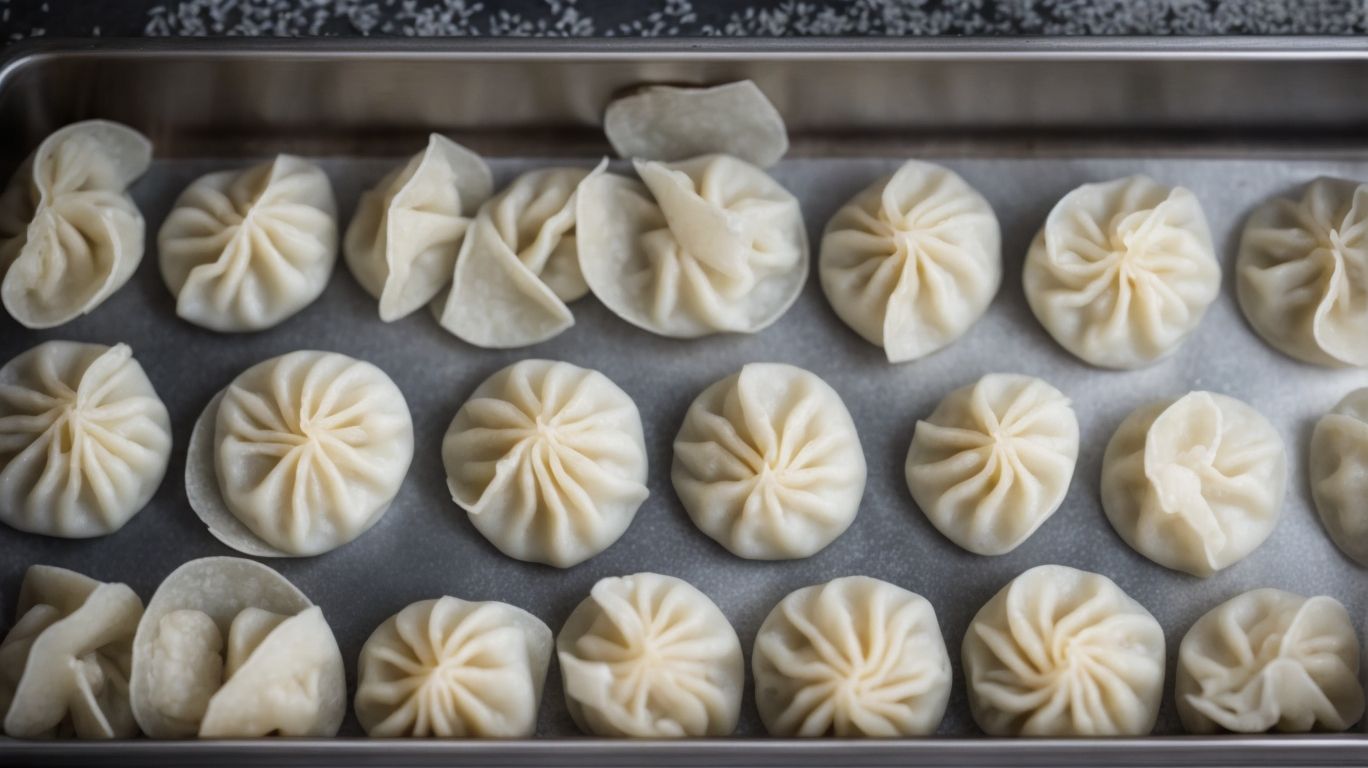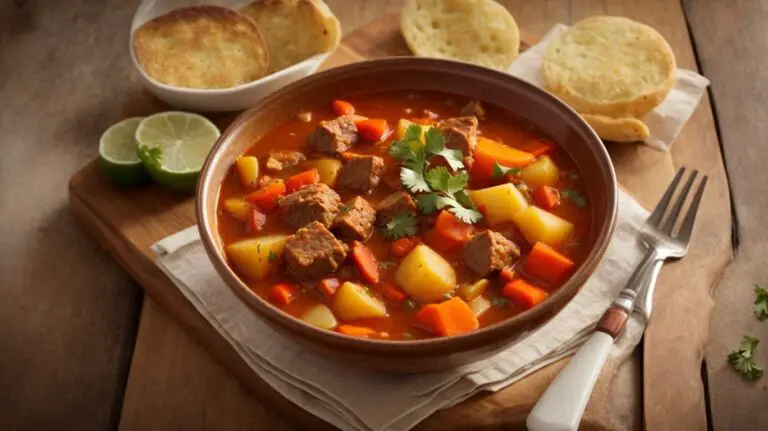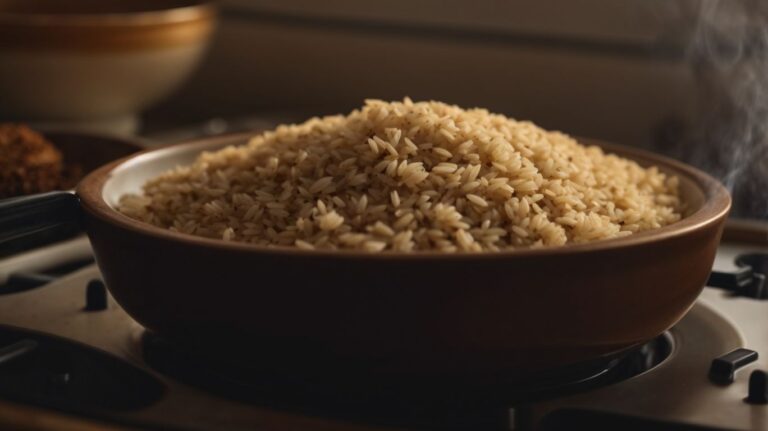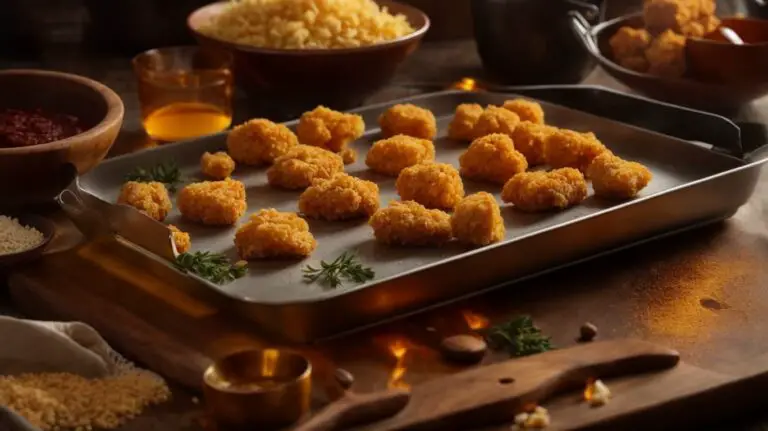How to Cook Dumplings From Frozen?
Have you ever wondered how to cook frozen dumplings to perfection?
We will explore everything you need to know about preparing and cooking frozen dumplings.
From thawing them properly to different cooking methods such as boiling, steaming, pan-frying, and deep-frying, we will cover it all.
Whether you’re a dumpling enthusiast or a beginner in the kitchen, these tips and tricks will help you make delicious homemade frozen dumplings that will impress your taste buds.
Let’s get cooking!
Key Takeaways:
What are Frozen Dumplings?
Frozen dumplings are pre-made dumplings that have been frozen to preserve their freshness and flavor until ready to be cooked.
One of the main benefits of using frozen dumplings is the convenience they offer. This ready-to-cook option saves time and effort in the kitchen, making it perfect for busy individuals or those who want a quick and delicious meal. Another advantage of frozen dumplings is their long shelf life, allowing you to stock up and have a go-to meal option whenever needed. Additionally, frozen dumplings come in a variety of flavors and fillings, catering to different tastes and preferences.
Why Cook Dumplings from Frozen?
Cooking dumplings from frozen saves time and allows for convenient meal preparation without compromising on taste or texture.
One of the key advantages of cooking dumplings directly from frozen is the elimination of thawing time, making it an ideal option for quick and easy meals. When you cook dumplings from frozen, they retain their moisture and flavor, resulting in a dish that is just as delicious as if they were freshly made. This method also ensures that the dumplings remain soft and tender, with a perfectly cooked filling. Frozen dumplings are a versatile ingredient that can easily be kept on hand for impromptu meals or unexpected guests, providing a budget-friendly and time-saving solution in the kitchen.
How to Prepare Frozen Dumplings for Cooking?
To prepare frozen dumplings for cooking, you need to follow specific thawing and cooking methods depending on your preferred cooking technique.
For thawing frozen dumplings, let them sit in the refrigerator overnight or place them in a bowl of cool water until they are no longer frozen.
Cooking options for frozen dumplings include boiling, steaming, pan-frying, or deep-frying. Boiling involves adding the dumplings to boiling water and cooking until they float to the surface.
Steaming is done by placing the dumplings in a steamer basket over simmering water for about 10-15 minutes.
To pan-fry, heat some oil in a pan, add the dumplings, and cook until the bottoms are golden brown before adding water and covering to steam.
Deep-frying requires submerging the dumplings in hot oil until they are crispy and cooked through.
Thawing Frozen Dumplings
Thawing frozen dumplings before cooking is crucial to ensure even cooking and optimal texture.
There are several methods to effectively thaw frozen dumplings. One common approach is to transfer the frozen dumplings from the freezer to the refrigerator the night before you plan to cook them. Slow thawing in the fridge helps maintain the texture of the dumplings and reduces the risk of bacterial growth.
Alternatively, you can use the cold water method for quicker thawing. Place the frozen dumplings in a sealed plastic bag and submerge them in a bowl of cold water. Change the water every 30 minutes to ensure a consistent temperature.
Whichever method you choose, follow these instructions closely to ensure that your dumplings thaw safely and are ready for a delicious cooking experience.
Preparing the Cooking Surface
Preparing the cooking surface for frozen dumplings involves heating a pan with oil to the right temperature for the chosen cooking method.
Ensuring that the oil is hot enough before adding the dumplings is crucial to achieving the perfect texture and crispiness. The sizzle that occurs when the dumplings touch the hot oil is a sign that the pan is ready. An important tip is to space the dumplings evenly in the pan, ensuring they do not touch each other, allowing them to cook evenly and develop a crisp bottom. Periodically rotating the dumplings in the pan helps to ensure that they are evenly browned on all sides, creating a delicious golden crust.
Different Ways to Cook Frozen Dumplings?
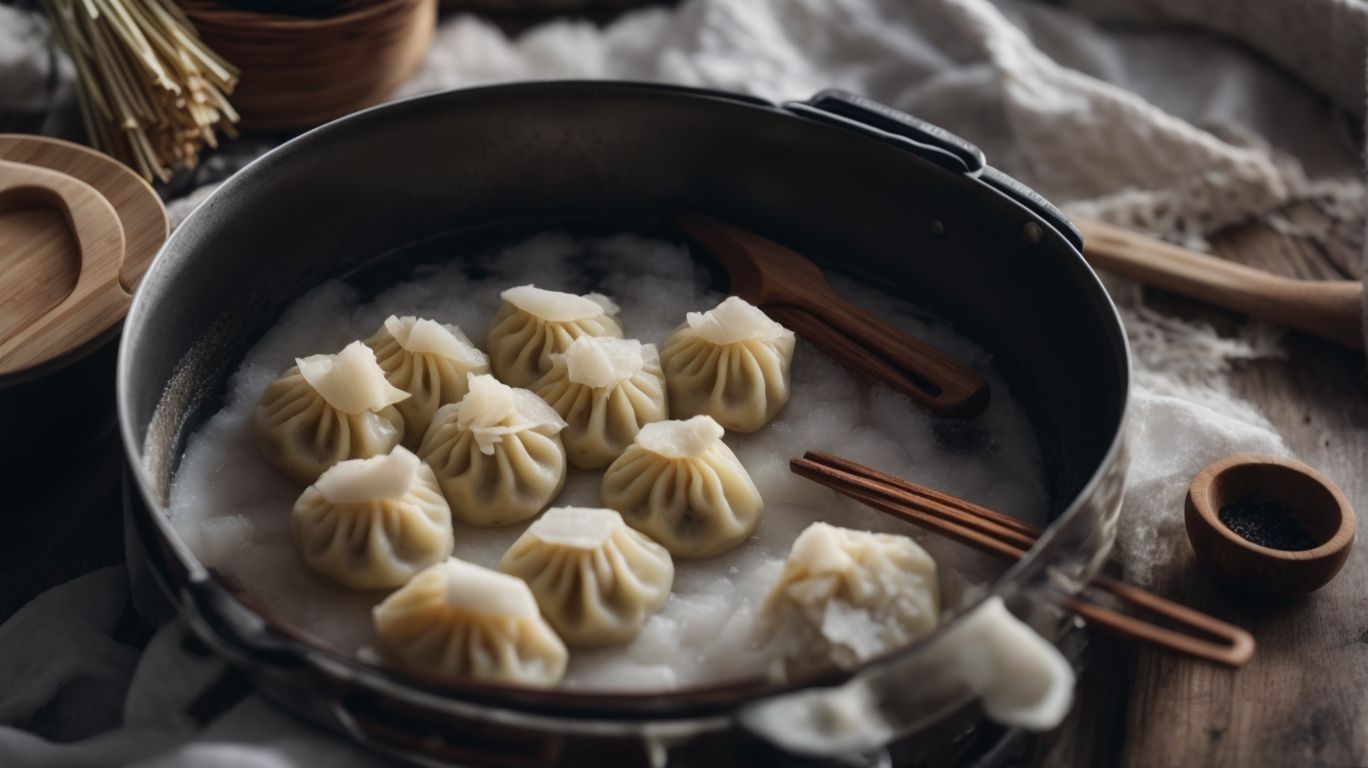
Credits: Poormet.Com – Brian Wilson
There are several methods to cook frozen dumplings, including boiling, steaming, pan-frying, and deep-frying, each offering a unique texture and flavor profile.
When boiling frozen dumplings, you’ll get a soft and tender wrapper with a moist filling.
Steaming them results in a lighter, more delicate texture and preserves the dumplings’ natural flavors.
Pan-frying lends a crispy bottom that adds a delightful crunch, while retaining a chewy top layer.
On the other hand, deep-frying creates a golden, crunchy exterior that contrasts beautifully with the juicy inside.
Boiling Frozen Dumplings
Boiling frozen dumplings is a common cooking technique that involves simmering the dumplings in water until they are fully cooked and tender.
When boiling frozen dumplings, it’s important to bring a pot of water to a gentle boil. Water temperature plays a crucial role in the cooking process as too high of a heat can cause the dumplings to break apart. Once the water reaches a steady simmer, carefully add the frozen dumplings. The cooking time will vary depending on the size and type of dumplings; typically, it takes around 6-8 minutes for them to cook through. For added flavor, consider preparing a dipping sauce with soy sauce, vinegar, and sesame oil to complement the savory dumplings.
Steaming Frozen Dumplings
Steaming frozen dumplings is a traditional Chinese cooking method that helps retain the dumplings’ moisture and delicate texture.
The process of steaming dumplings requires the use of a steamer, which allows the hot steam to evenly cook the dumplings without compromising their texture. The steam gently permeates through the dumpling wrappers, keeping them soft and supple. As the dumplings steam, the fillings release their flavors, creating a juicy and flavorful bite. This gentle cooking method ensures that the dumplings remain moist and tender, preserving the authenticity of Chinese cuisine. Steaming not only cooks the dumplings thoroughly but also enhances their natural flavors, making each bite a delectable experience.
Pan-Frying Frozen Dumplings
Pan-frying frozen dumplings creates a crispy and golden exterior while locking in the juicy fillings for a delightful contrast in textures.
When pan-frying dumplings, it’s essential to use a good amount of oil to ensure even cooking and achieve that perfect crunch. The heating process is crucial – make sure the oil is hot but not smoking before adding the dumplings to the pan. Gentle movements are key; avoid overcrowding the pan to allow each dumpling space to crisp up evenly. This method not only enhances the flavor but also adds a satisfying crunch to each bite, elevating the overall dining experience.
Deep-Frying Frozen Dumplings
Deep-frying frozen dumplings results in a crunchy and indulgent treat, with the outer shell becoming crispy and golden while the filling remains succulent.
When utilizing the deep-fry method, it is crucial to ensure that the oil reaches the optimal temperature before submerging the dumplings. The oil should ideally be heated to around 350-375°F to achieve that perfect balance of crispiness and tenderness. As the dumplings fry in the hot oil, the moisture inside turns into steam, creating a contrast between the crisp outer layer and the juicy interior. This process yields a delightful texture that tantalizes the taste buds.
Tips for Cooking Frozen Dumplings
To ensure the best results when cooking frozen dumplings, follow these essential tips and techniques for a delicious and satisfying meal.
When preparing frozen dumplings, make sure not to overcrowd the pan as it can affect the cooking process. Utilizing the right equipment such as a non-stick skillet or a steaming basket can enhance the texture and flavor of the dumplings.
To check for doneness, pierce a dumpling with a fork to ensure it is cooked through without being mushy in the center. Serving the dumplings with a variety of complementary dipping sauces like soy sauce, chili oil, or vinegar can elevate the taste experience and add a burst of flavor to each bite.
Do Not Overcrowd the Pan
One crucial tip for cooking frozen dumplings is to avoid overcrowding the pan, as this can lead to uneven cooking and affect the texture of the dumplings.
When the pan is overcrowded, the dumplings end up steaming rather than frying, resulting in a soggy and mushy texture.
For optimal cooking efficiency and that perfect crispy exterior, ensure there is ample space between each dumpling in the pan.
By giving each dumpling its own space, you allow for proper airflow and heat distribution, promoting even browning and a delightful crunch.
Use a Non-Stick Pan for Pan-Frying
When pan-frying frozen dumplings, opt for a non-stick pan to prevent sticking and ensure a crispy exterior without compromising the filling’s texture.
Non-stick pans offer a smooth cooking surface that requires minimal oil, promoting healthier cooking options while reducing the risk of burning the dumplings. The slick surface also aids in achieving an even browning, giving your dumplings that desirable golden hue. Using a non-stick pan simplifies the clean-up process, as it prevents food residue from clinging to the pan, making it effortless to wash.
Check for Doneness
To determine if frozen dumplings are fully cooked, check for doneness by ensuring the wrappers are translucent and the fillings are hot throughout.
One key visual cue to look for when cooking frozen dumplings is the translucency of the wrappers. When the dumplings are ready, the wrappers should appear slightly transparent, indicating that they are properly cooked and not raw.
To assess the doneness, you can check the texture of the fillings. The fillings should be piping hot throughout when you break open a dumpling, ensuring that they are thoroughly cooked and safe to eat.
Serve with Dipping Sauce
Enhance the flavor of frozen dumplings by serving them with a variety of dipping sauces that complement the dish and add an extra layer of taste to the meal.
In terms of elevating the dining experience, dipping sauces play a crucial role in tantalizing the taste buds. Whether you prefer a sweet chili sauce for a kick of heat or a savory soy-based dipping sauce for a more subtle flavor enhancement, the right pairing can truly take your frozen dumplings to the next level.
- For those who enjoy a blend of sweetness and spice, a teriyaki sauce can be an excellent choice to complement the rich flavors of pork or chicken dumplings.
- On the other hand, if you crave a tangy and refreshing twist, consider serving your dumplings with a zesty ginger soy dipping sauce.
Conclusion: Enjoy Your Homemade Frozen Dumplings!
Savor the delicious results of your culinary efforts by relishing the homemade frozen dumplings prepared with care and attention to detail.
Picture yourself in the cozy kitchen, the aroma of simmering dumplings filling the air as you lovingly fold each delicate wrapper, a dance of hands connecting the past and present. With each dumpling-shaped memory sealed in the freezer, anticipation grows for that moment of satisfaction. The beauty of these homemade delights lies not just in their taste but in the journey cherished. And when the time comes to dip them in your favorite sauce, the simple act of relishing every homemade bite becomes a celebration of the heartwarming process of creation.
Frequently Asked Questions
How to Cook Dumplings From Frozen?
1. What is the best method for cooking dumplings from frozen?
The best method for cooking frozen dumplings is to boil or steam them. This helps to retain their shape and texture while also fully cooking the filling inside.
2. Can I fry frozen dumplings directly?
No, it is not recommended to fry frozen dumplings directly. This can cause the dumplings to become soggy and unevenly cooked. It’s best to boil or steam them first before frying to achieve a crispy texture.
3. How long do I need to boil frozen dumplings?
The boiling time for frozen dumplings can vary depending on the type and size of the dumplings. Generally, it takes about 5-7 minutes for smaller dumplings and 10-12 minutes for larger ones. Always refer to the package instructions for the specific cooking time.
4. Can I add frozen dumplings directly to a soup or stew?
Yes, you can add frozen dumplings directly to a soup or stew. Just make sure to increase the cooking time by a few minutes to ensure that the dumplings are fully cooked.
5. Do I need to defrost frozen dumplings before cooking them?
No, you do not need to defrost frozen dumplings before cooking them. In fact, cooking them directly from frozen helps to preserve their shape and texture.
6. How can I tell if the frozen dumplings are fully cooked?
You can tell if the dumplings are fully cooked by cutting one open and checking if the filling is cooked through. It should be hot and steaming. You can also use a food thermometer to ensure that the internal temperature of the dumplings reaches 165°F (74°C).

